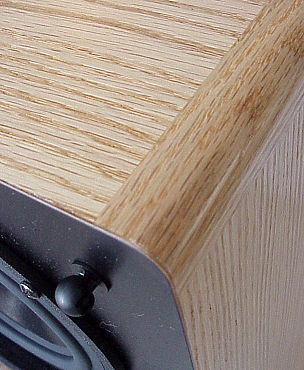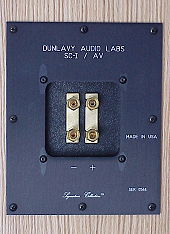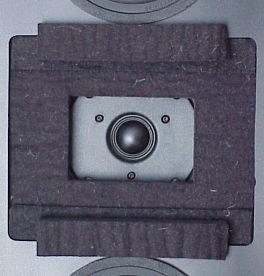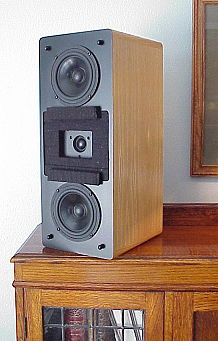Product Review - Dunlavy SC-1/AV
Home Theater Speakers - September, 1999
John E. Johnson, Jr.
![]()
|
Dunlavy SC-1/AV Speakers One 1" Cloth Dome Tweeter, Two 4 1/2" Mid/Bass Drivers MFR: 70 Hz - 20 kHz � 1.5 dB Impedance: Nominal 7 Ohms Sensitivity: 91 dB - 2.83 Volts Applied Size: 20" H x 8" W x 10 1/2" D Weight: 25 Pounds Each MSRP: $1,500/Pair ($3,750 for the set of 5) USA (Natural Oak or Black Oak) - Cherry and Rosewood Optional. |
|
Dunlavy Audio Labs, P.O. Box 49399, Colorado Springs, Colorado 80949-9399; Phone 719-592-1159; Fax 719-592-0859; Web http://www.dunlavyaudio.com. |
Dunlavy Audio is an unusual company,
in that even their least expensive model is expensive. There is no entry-level
model. You just choose whether you want the little ones ($), the mid-sized ones
($$), or the big ones ($$$). The reasons for that
are straightforward: Every speaker is calibrated (adjusted) for
frequency response in an anechoic chamber before it is shipped out, and every
speaker has exceptional wood finishing, even on the back and on the bottom. Wood grained vinyl is not an option
with Dunlavy. I am a fan of real wood, and I was delighted when I received the
set of SC-1/AVs, as natural oak is one of my favorites. They come with a black
grille cloth, but I photographed the example here with the grille removed, for
illustration purposes.
I requested the SC-1/AVs as a set of
five, all exactly the same, since 5.1 digital surround sound necessitates
balanced tonality all the way around. One could call this an L/C/R set, as the
center is the same as the front left and right speakers. They are all
magnetically shielded, thus the AV designation. These speakers are very heavy
for monitors, being 25 pounds each. That's a good sign of quality craftsmanship.
Another good indicator is the solidly dead sound that the enclosure gives when
one raps on the top. [Click the video button below left to see the demonstration.] The
![]() corners of the
enclosure are finished with inserts rather than just bending the veneer around
the edge (see photo at right). Again, another sign of superb craftsmanship. One
might wonder if such beautiful external build would affect the sound. Well, no,
not directly. But what it does imply is that a lot of pride has gone into the
construction, and therefore, it is highly likely that a fine sound will
accompany the looks. As you will see, my hypothesis was confirmed.
corners of the
enclosure are finished with inserts rather than just bending the veneer around
the edge (see photo at right). Again, another sign of superb craftsmanship. One
might wonder if such beautiful external build would affect the sound. Well, no,
not directly. But what it does imply is that a lot of pride has gone into the
construction, and therefore, it is highly likely that a fine sound will
accompany the looks. As you will see, my hypothesis was confirmed.
One external item that does directly affect the sound can be seen when the grille is removed. Dunlavy has patented this feature, namely, the placement of wool felt pads around the tweeter (a cloth dome variety). As you probably know, when sound (the waveform) comes out of one driver on the front of the enclosure, it will interact with the sound (another waveform) coming from other drivers nearby on the front of the enclosure, causing diffraction. By placing the felt pads around the tweeter, diffraction (interaction between the tweeter waveform emerging, and the mid/bass waveforms emerging) is reduced. The tweeter in between two mids is called the D'Appolito configuration, after a speaker designer with the same name. It makes the sound of the highs and lows blend together, in placement, rather than the highs coming from the top of the speaker and the mids from the bottom. The tweeter on the SC-1/AV is deeper into the enclosure compared to the mid-range drivers. This aligns the phase of the emerging waveforms.
The rear panel is finished in oak, just
like the other sides, and has a bi-wireable/bi-ampable set of four gold plated
binding posts (photo below, left). They are some of the most solid binding posts
I have yet seen. Frankly, I am surprised that these speakers are only $1,500 a
pair. Nary a feature has been short changed.  Top
notch every step of the way.
Top
notch every step of the way.
I tested the SC-1/AVs in a home theater environment, using our Yamaha reference equipment. The Dunlavys are 7 Ohm loads, and they have excellent sensitivity. Even though the amplifiers in the Yamaha DSP-A1 are very good, they still work best with sensitive higher impedance speakers, as do just about all receivers. I have to say right up front, that the SC-1/AVs are some of the most neutral sounding speakers I have ever heard. This is critically important with human voices, which is something we get in every movie soundtrack (unless you are watching an old Charlie Chaplin film). One thing I have noticed over the years is how many speakers seem to accentuate certain frequencies. I suppose some do it on purpose, but I prefer neutrality. At first, this can seem a little less exciting than having some of the frequencies boosted, but once you get used to true fidelity, it becomes the only way to go. Four areas I have found to be particularly irritating are in the 80 Hz band (boomy), 120 Hz band (chesty), 800 Hz band (nasal), and 6 kHz band (sibilance). With musical instruments, aberrations in these bands are not really all that noticeable, but with voices, and also with certain sound effects, watch out! Apparently, Dunlavy has had the same idea, because they are very careful with these frequency bands. In fact, each speaker is hand measured in an anechoic chamber and adjusted for a flat frequency response. Of course, our rooms at home are far from being anechoic chambers, but at least you don't have to worry about the speakers having dips or peaks all their own to contend with. The result is complete and utter neutrality, which is very, very refreshing. If you want to crank up the highs or the lows, do it with an EQ or the subwoofer. Speaking of subwoofers, the Dunlavys are good down to 80 Hz or so, and they expect you to add your own bass to suit your tastes.
With speakers that are chesty and overly
sibilant, gunshots can make you put your hands over your ears. With the Dunlavys,
gunshots were tolerable (God help us). Since cigarette smoking is a little
gauche these days, it was nice that the SC-1/AV's smooth response didn't make
anyone sound like they were a two pack a day actor. I should point out that the
SC-1/AVs are soooooo good, you will want a top quality subwoofer to go with
them.  Forget the 10" 80 watt variety. Go for something that will take you
into the netherworld of < 20 Hz. In this case, I used a Velodyne HGS-18 to
keep the floorboards nice and loose. Even when played loud, everything was clear
at all frequencies, including machine gun fire (please God, help us). The combo
of the DSP-A1, SC-1/AVs, and HGS-18 are going to be the next "Recommended
System" in Secrets. Now, that is music!
Forget the 10" 80 watt variety. Go for something that will take you
into the netherworld of < 20 Hz. In this case, I used a Velodyne HGS-18 to
keep the floorboards nice and loose. Even when played loud, everything was clear
at all frequencies, including machine gun fire (please God, help us). The combo
of the DSP-A1, SC-1/AVs, and HGS-18 are going to be the next "Recommended
System" in Secrets. Now, that is music!
I also tested the Dunlavys in our reference two-channel stereo system, which includes a Class A triode tube preamplifier and MOSFET monoblock power amplifiers. Cables are Nordost Red Dawn. A Sunfire subwoofer is in charge of window rattling. Here, as with movie soundtracks, the music was utterly neutral, and also breathtakingly clear. The former is courtesy of all that hand calibrating, and the latter is due to the felt baffling near the tweeter. There are plenty of excellent speaker drivers out there, that anyone can buy. But, it's all this fine tuning that makes such a tremendous difference in the listening experience. My favorite test CD for voices is Natalie Cole's "Unforgettable". She has a very tough voice to reproduce, and she sings close to the microphone. With the Dunlavys, Natalie sounded about as close to perfect as one can get. No chestiness, no nasality, no extra sibilance. And that puts Ms. Cole right in the living room. Marc Cohn also has a great voice for testing speakers. He is a tenor, so even a hint of chestiness would be very apparent. Nope, it didn't happen with the Dunlavys. For classical music, the SC-1/AVs shone. The delicate harpsichord of Vivaldi, the thunderous piano of Rachmaninov, the multi-octave layers of Tchaikovsky. All clear as the proverbial bell.
In summary, the Dunlavy SC-1/AVs are really quite incredible. I don't see a big profit margin here. What I do see is a company that likes their customers to have as good a sound as the Dunlavy staff do in their own homes. There are no compromises with these speakers. Great sound. Great looks. Great price. Zero reservations.
- John E. Johnson, Jr. -
![]()
� Copyright 1999 Secrets of Home Theater & High
Fidelity
Return to Table of Contents for this Issue.


